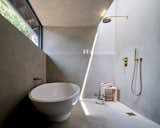Collection by Carmel Bennett
The architects worked with the natural, six-foot slope of the site and built the Granny Pad into the hill to gain the needed interior height. The volume on the right is the original garage footprint, which now houses a kitchen and sitting room. The added volume on the left hosts the bedroom, as well as a bathroom beneath the loft space.
Just north of San Francisco, the Mill Valley home of former Phish manager and current restaurant owner John Paluska takes its place within its eclectic neighborhood and natural surroundings. A guest cottage flanks the family's garden. The "casita" has hosted friends, family, and even wildfire evacuees; Rachel Paluska refers to it as a "revolving door, in a fun way."
Clustered around a sunny courtyard, Three Piece House’s three volumes—a main house, comprising two volumes (one for living and the other for sleeping) connected via a sun-soaked reading corridor, and a free-standing guest studio—are oriented for optimal passive solar conditions, including access to cooling ocean breezes. Recycled brick paving ties the volumes together. Located in the garden, the studio accommodates visiting friends, family, and guests.
Specializing in customized, modular units for residential backyard use, the Los Angeles–based startup Cover is out to transform the market with their high-quality prefabs. This Los Angeles suite was created for clients who were looking for a beautiful and functional space for their in-laws to live in. It was designed with all the amenities needed for independent living including a full kitchen, living space, bathroom, bedroom, office, and laundry space.
Founded in 2014 by Alexis Rivas and Jemuel Joseph, Cover was born out of a frustration with the current residential building climate. Based on a belief that great design should be available to everyone, Cover strives to design for manufacturability, looking to Apple and Tesla for inspiration—as opposed to the traditional architectural model. This West Los Angeles pool and guesthouse is 410 square feet and features a full kitchen, bedroom, and bathroom. It also doubles as a pool house. The compact design features floor-to-ceiling windows to bring the outside in.
Fifty miles north of New York City, a controversial home and guesthouse were built from Frank Lloyd Wright’s drawings on a private island. Intriguingly, the main home was completed in 1996 following Wright's original sketches for the 1950s owner of the island, who ultimately instead commissioned a 1,200-square-foot home on the island because of the high cost. Today, that 1,200-square-foot home serves as a three-bedroom guesthouse—the perfect space for extended family to stay.
Architect Rocio Romero designs ADUs that are conceived as studios, backyard offices, guest cottages, and short-term getaways. She’s sold over 50 prefab units in 17 different states, and recently launched a series of more modestly sized, construct-it-yourself structures dubbed the Camp series. The 456-square-foot Base Camp and 312-square-foot Fish Camp will both be priced in the $20,000 range. At just over 300 square feet, the Fish Camp is the smaller of the two Camp styles, but the prototype illustrates its utility as guesthouse or office.
A new addition to Sea Ranch’s enclave of utopian homes, this structure (and the separate guesthouse seen here) clad in rough concrete and Cor-ten steel seamlessly blends in with its half-a-century-old California neighbors. Designed by the dean of the Woodbury School of Architecture and the head of the University of Oregon’s architecture department, its spaces flow into one another underneath an angled plywood ceiling and illuminate built-in furniture crafted from vertical-grain Douglas fir.
Spurred by the city’s generous ADU incentives and a desire to reduce their environmental footprint, a couple—he an architect and she a construction engineer—designed and built an elegant, 624-square-foot backyard home with sustainability at its core. Scott Mooney and Lauren Shumaker’s compact backyard home is located in the back half of their 5,000-square-foot lot in the Richmond neighborhood of Southeast Portland. The couple plans to track the energy use of their new-build’s electric equipment and appliances. The data will inform the size of their photovoltaic array they'll add to offset the energy costs of the ADU and the bungalow.
16 more saves



















